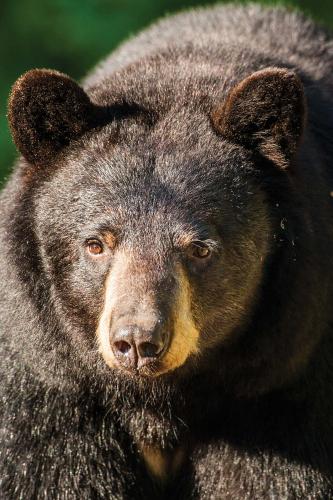Black Bear
When my colleagues told me about recent black bear sightings in southwest Missouri, I was intrigued, but I wasn’t optimistic about capturing the notoriously shy and wary animal on camera.
Black bears were considered nonexistent in Missouri by the mid- 1900s due to unregulated hunting and habitat destruction by the state’s early settlers. In fact, sightings were considered rare up until the early 2000s when black bears slowly started a comeback, migrating north from Arkansas where populations had increased.
In early May, a landowner spotted a large female black bear with three yearling cubs on his property and informed the Department. He mentioned that the sow appeared to be about 300 pounds. I was skeptical of his estimation since most black bears I photographed in Montana and Canada typically weighed in at 250 pounds.
I decided to set up a photo blind at the edge of a forest where they were spotted just a day earlier. Bears have an incredible sense of smell and hearing but poor eyesight, so I was hoping my blind would be the cover I’d need to get a perfect photo.
Around 5 a.m., I slowly approached my blind, careful not to spook anything. Once inside, I carefully assembled my gear and waited. When I opened my blind window, imagine my surprise when I saw bears only 150 yards away.
First, there were two cubs, and then a third one arrived soon after. Then I saw a sow walking slowly behind them, cautious of her surroundings. She was huge and probably weighed 350 pounds, more than the landowner’s initial estimate. Later I learned that black bears in the south are much larger than their cousins to the north due to food availability and less competition from much larger grizzly bears. I spent the next few weeks with this black bear family, learning their routine and habits. I also learned to recognize the bear cubs’ calls.
One morning while waiting inside my blind, a sow made a beeline in my direction. Looking through my telephoto lens, I could see she was on a mission. A sow is known to be very protective and will fight any threat to her offspring. She started to chomp her teeth and look for an intruder.
My hands were shaking as I continued to photograph her. She came within 20 feet of my blind, her face filling my entire camera viewfinder. I took a few shots then paused, trying not to scare her. I could hear her fast breathing. She stared hard at my blind for what seemed like an eternity — but in reality was probably just a few secon—before turning around and heading back into the forest —I took a deep breath and stayed in my blind for another 30 minutes to be sure I was alone. It was an experience I will never forget.
—Story and photograph by Noppadol Paothong
We help people discover nature through our online Field Guide. Visit mdc.mo.gov/node/73 to learn more about Missouri’s plants and animals.




And More...
This Issue's Staff
Editor - Angie Daly Morfeld
Art Director - Cliff White
Staff Writer/Editor - Bonnie Chasteen
Staff Writer - Heather Feeler
Photographer - Noppadol Paothong
Photographer - David Stonner
Designer - Stephanie Thurber
Circulation - Laura Scheuler






















